Ten years of ranavirus research (2010–2019): an analysis of global research trends
Abstract
Ranaviruses are large nucleocytoplasmic DNA viruses that infect ectothermic vertebrates. Here we report the results of a scientometric analysis of the field of ranavirology for the last 10 years. Using bibliometric tools we analyse trends, identify top publications and journals, and visualise the ranavirus collaboration landscape. The Web of Science core collection contains 545 ranavirus-related publications from 2010 to 2019, with more publications produced every year and a total of 6830 citations. Research output is primarily driven by the United States and People’s Republic of China, who together account for more than 60% of ranavirus publications. We also observed a positive correlation between the average number of co-authors on ranavirus publications and the year of publication, indicating that overall collaboration is increasing. A keyword analysis of ranavirus publications from 2010 to 2019 reveals several areas of research interest including; ecology, immunology, virology/molecular biology, genetics, ichthyology, and herpetology. While ranavirus research is conducted globally, relatively few publications have co-authors from both European and Asian countries, possibly because closer countries (geographical distance) are more likely to share co-authors. To this end, efforts should be made to foster collaborations across geopolitical and cultural boundaries, especially between countries with shared research interests as ultimately, understanding global pathogens, like ranaviruses, will require global collaboration.
Introduction
Ranaviruses are a group of large double-stranded DNA viruses in the genus Ranavirus (family Iridoviridae), which infect ectothermic vertebrates including fish, amphibians, and reptiles (Gray and Chinchar 2015). The first of these viruses was isolated in 1965; however, it was not until the late 1980s that they were recognized as pathogens of ecological and economic importance (Gray and Chinchar 2015). Since their initial discovery, ranaviruses have been isolated from hosts in both temperate and tropical habitats from around the globe (Duffus et al. 2015).
The wide distribution of ranaviruses has led to global research interest, resulting in the establishment of the Global Ranavirus Consortium (GRC). The GRC, formed in 2011, aims to foster collaboration and knowledge sharing between ranavirus researchers and appropriate stakeholders (Lesbarrères et al. 2012). Since its formation, the GRC has organised five international symposiums on ranaviruses to bring the global ranavirus research community together. Work presented at these symposiums has emphasised the breadth and diversity of the ranavirus research field (Lesbarrères et al. 2012). In 2019, the ISR was held in Australia and covered a range of topics including ecology, pathology, immunology, and diagnostics. Although an important part of fostering research collaboration, and in identifying trends and knowledge gaps, conference presentations are only a small part of the ranavirus research field, and most studies are published in the peer-reviewed scientific literature.
Bibliometrics are a set of tools used to measure and study texts and information associated with interrelated bodies of documents. Commonly, these tools are applied to the scientific literature (scientometrics) for the comparative analysis of research institutes, journals of publications, and individual researchers. Scientometrics can also be used for gaining an understanding of the intra/interdisciplinary collaboration, trends in research topics, and overall structure of a field of scientific research via the generation of bibliometric maps. Collaboration has been linked to increased impact, research output, and citation rates (Lee and Bozeman 2005; Figg et al. 2006; Larivière et al. 2015). In this study, we report the results of a scientometric analysis of the field of ranavirology for the past 10 years and, in particular, how collaborations have moved this field forward.
Methods
The bibliographic data for the publications used in this study were downloaded from the Web of Science (WOS) core collection database using the search term “ranavirus”. Only publications from 2010 to 2019 and reported as “article” or “review” were included in the data set. The filtered data set contains 545 publications and is referred to as the WOS ranavirus data set throughout this manuscript. General statistics and figures were generated and produced using Python 3 (McKinney 2010; Seabold and Perktold 2010). All correlation analyses were performed using a Pearson’s product-moment correlation.
Top core ranavirus publications were determined by counting the number of citations from ranavirus-related publications in the WOS ranavirus data set (internal citations). Top auxiliary ranavirus publications were determined by subtracting the number of internal citations from the total number of citations to determine the number of citations each publication received from publications outside of the WOS ranavirus data set. To assess the main ranavirus publication outlets and if these journals were likely to be read by a large audience, we calculated the H-Index of all journals in the WOS ranavirus data set.
To visualise research topic groups in the ranavirus field, a co-occurrence map was created for all keywords, with at least five occurrences using the software package VOSviewer (van Eck and Waltman 2010). The median year of occurrence of each author keyword was also determined to get an idea of research topic trends within the field, and a frequency count of author keywords per year was created to determine how research interests have changed overtime.
The VOSviewer software package was also used to construct collaboration maps for the ranavirus field (van Eck and Waltman 2010). Two bibliographic maps were created to visualise the ranavirus field at the country level. First, co-authorship coupling was used to determine which countries are collaborating. While co-authorship is not the only form of collaboration, it remains a reliable and measurable indicator (Larivière et al. 2015). Second, bibliographic coupling was used to determine which countries are producing publications that cite the same publications in their reference lists. Shared references are assumed to represent a similar research interest. Countries with <5 ranavirus-related publications were excluded from the visualizations (21 of the 48 ranavirus publishing countries passed this threshold). Fractional counting was used to minimise bias of publications with many co-authors (Perianes-Rodriguez et al. 2016). All other VOSviewer parameters were left as default. To determine the effect of geographic location on co-authorship, distance matrices were created for country nodes in the co-authorship map and for the actual geographical coordinates of the countries; a Mantel test was used to compute the Pearson’s product-moment correlation between the two distance matrices.
Results
Publications and citations
There are 545 publications in the WOS ranavirus data set published between 2010 and 2019 (average per year = 58.2, SD = 15.2), with a significantly increasing number of publications per year from 41 in 2010 to 86 in 2019 (R = 0.87, p < 0.001; Fig. 1). The greatest number of ranavirus publications between 2010 and 2019 came from the United States (US) and People’s Republic of China (PRC) who had 199 and 153 total publications, respectively, together accounting for more than 60% of ranavirus-related publications in that time period (Table 1). Out of all the countries with more than five publications in the WOS ranavirus data set, the US and PRC are the only countries with a strong increase in publication output (Fig. 2). Publications in the WOS ranaviurs data set between 2010 and 2019 were cited a total of 6830 times with publications from 2010 having the highest collective citation total (1330) compared with any other year (Fig. 3). On average, over the last 10 years, each ranavirus-related publication has been cited 12.5 times (SD = 18.4, median = 7).
Fig. 1.
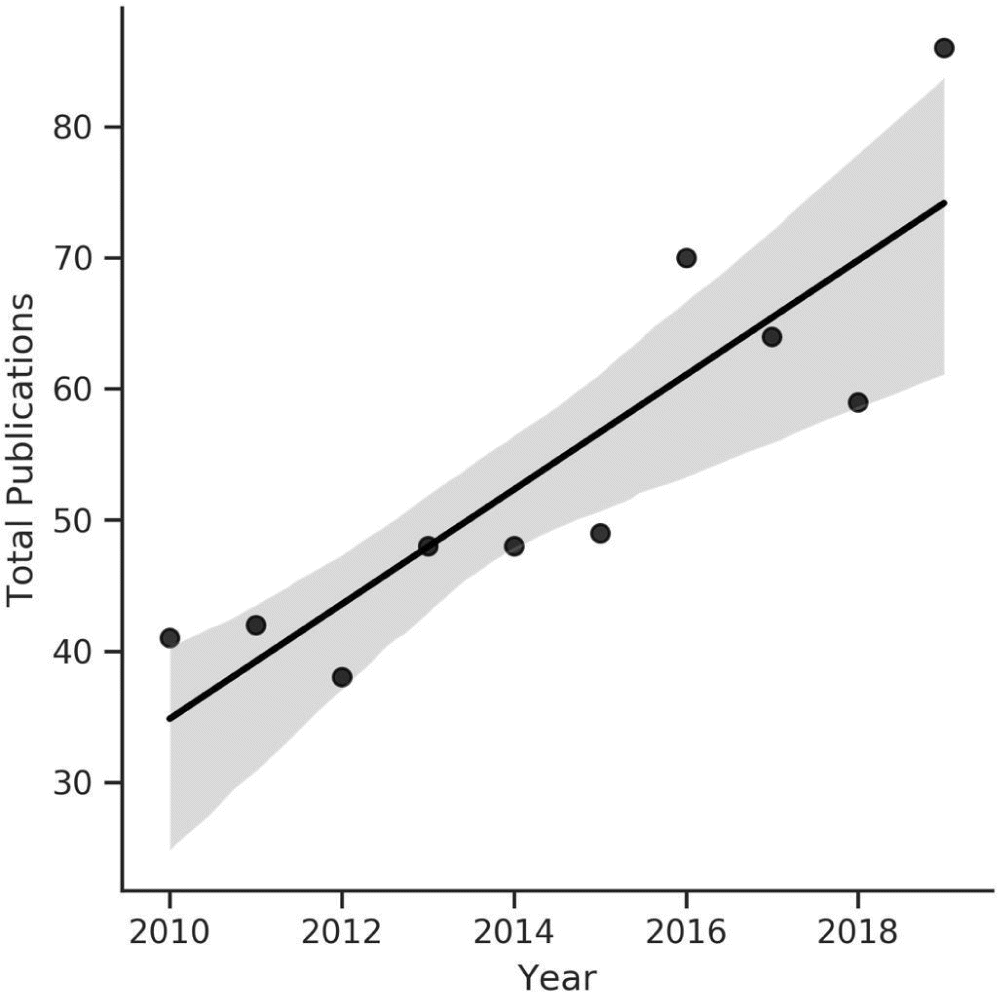
Fig. 2.

Fig. 3.
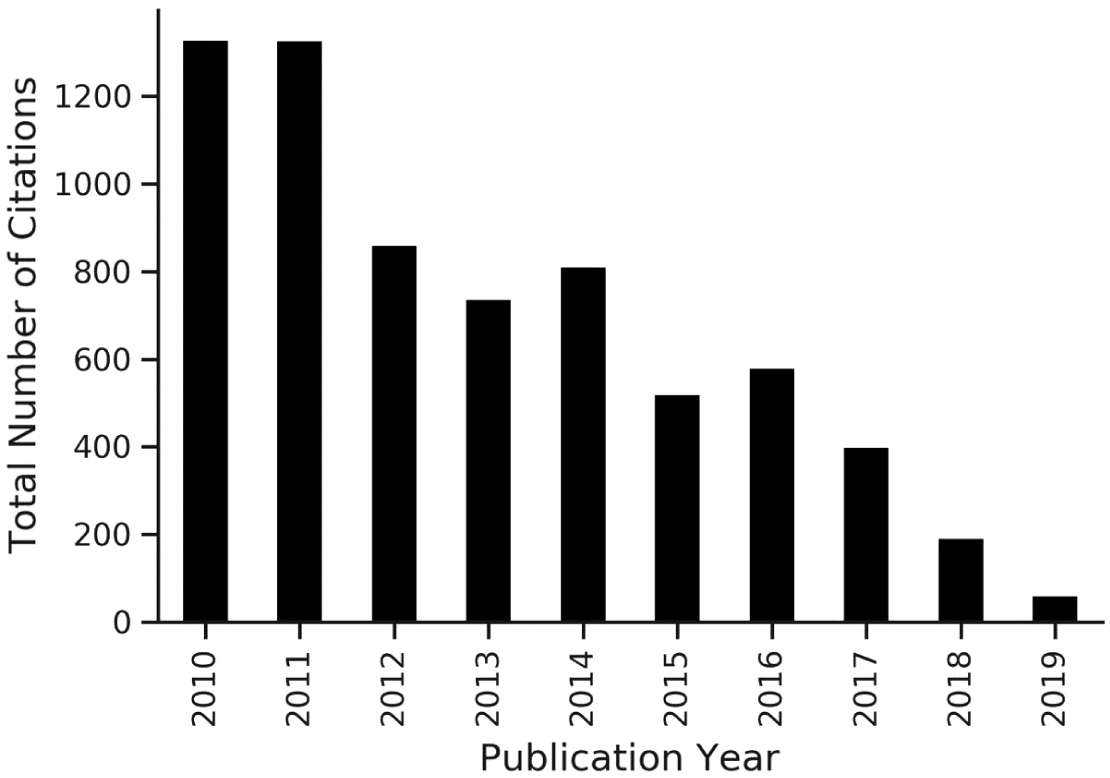
Table 1.
| Country | Total | Proportion (%) | Average per year |
|---|---|---|---|
| United States | 199 | 37 | 19.9 |
| People’s Republic of China | 153 | 28 | 15.3 |
| Canada | 32 | 6 | 3.2 |
| Australia | 27 | 5 | 2.7 |
| England | 22 | 4 | 2.2 |
| Taiwan | 16 | 3 | 1.6 |
| Germany | 14 | 3 | 1.4 |
| Spain | 12 | 2 | 1.2 |
| The Netherlands | 8 | 1 | 0.8 |
| Singapore | 8 | 1 | 0.8 |
| Belgium | 6 | 1 | 0.6 |
Note
The country of research origin is determined by the corresponding author’s address. Total, total number of publications; Proportion, proprotion of the total global ranavirus research output; Average per year, number of publications.
Top publications and journals
The H-index across all publications in the WOS ranavirus data set was 37. Ranavirus-related publications in the WOS ranavirus data set can be divided into top core (Table 2) and auxiliary (Table 3) publications. The top core ranavirus publications are highly cited by other ranavirus-related publications in the WOS data set. The ranavirus publication with the highest number of internal citations (i.e., citations from other publications in the WOS ranavirus data set) is Miller et al. (2011, Table 2). The top 10 core publication list contains several reviews (e.g., Whittington et al. 2010; Chinchar et al. 2011; Miller et al. 2011) that, because of their impact, may be a useful starting resource for those interested in ranavirology. The top auxiliary publications are cited by publications from outside the WOS ranavirus data set. The top auxiliary publication was Hayes et al. (2010) with a total of 176 citations in the WOS core collection.
Table 2.
| Authors | Title | Year | Journal | Citations | Internal citations | DOI | |
|---|---|---|---|---|---|---|---|
| 1 | Miller, D; Gray, M; Storfer, A | Ecopathology of ranaviruses infecting amphibians | 2011 | Viruses | 102 | 91 | 10.3390/v3112351 |
| 2 | Whittington, RJ; Becker, JA; Dennis, MM | Iridovirus infections in finfish—critical review with emphasis on ranaviruses | 2010 | Journal of Fish Diseases | 123 | 74 | 10.1111/j.1365-2761.2009.01110.x |
| 3 | Jancovich, JK; Bremont, M; Touchman, JW; Jacobs, BL | Evidence for multiple recent host species shifts among the ranaviruses (family Iridoviridae) | 2010 | Journal of Virology | 87 | 68 | 10.1128/JVI.01991-09 |
| 4 | Hoverman, JT; Gray, MJ; Haislip, NA; Miller, DL | Phylogeny, life history, and ecology contribute to differences in amphibian susceptibility to ranaviruses | 2011 | EcoHealth | 73 | 64 | 10.1007/s10393-011-0717-7 |
| 5 | Teacher, AGF; Cunningham, AA; Garner, TWJ | Assessing the long-term impact of Ranavirus infection in wild common frog populations | 2010 | Animal Conservation | 81 | 57 | 10.1111/j.1469-1795.2010.00373.x |
| 6 | Price, SJ; Garner, TWJ; Nichols, RA; Balloux, F; Ayres, C; de Alba, AMC; Bosch, J | Collapse of amphibian communities due to an introduced ranavirus | 2014 | Current Biology | 81 | 54 | 10.1016/j.cub.2014.09.028 |
| 7 | Morales, HD; Abramowitz, L; Gertz, J; Sowa, J; Vogel, A; Robert, J | Innate immune responses and permissiveness to ranavirus infection of peritoneal leukocytes in the frog Xenopus laevis | 2010 | Journal of Virology | 67 | 53 | 10.1128/JVI.02486-09 |
| 8 | Hoverman, JT; Gray, MJ; Miller, DL | Anuran susceptibilities to ranaviruses: role of species identity, exposure route, and a novel virus isolate | 2010 | Diseases of Aquatic Organisms | 58 | 51 | 10.3354/dao02200 |
| 9 | Geng, Y; Wang, KY; Zhou, ZY; Li, CW; Wang, J; He, M; Yin, ZQ; Lai, WM | First report of a ranavirus associated with morbidity and mortality in farmed Chinese giant salamanders (Andrias davidianus) | 2011 | Journal of Comparative Pathology | 69 | 49 | 10.1016/j.jcpa.2010.11.012 |
| 10 | Chinchar, VG; Yu, KH; Jancovich, JK | The molecular biology of Frog virus 3 and other iridoviruses infecting cold-blooded vertebrates | 2011 | Viruses-Basel | 64 | 38 | 10.3390/v3101959 |
Note
Publications are ranked by most citations from other publications in the Web of Science ranavirus data set (internal citations).
Table 3.
| Authors | Title | Year | Journal | Citations | Internal citations | DOI | |
|---|---|---|---|---|---|---|---|
| 1 | Hayes, TB; Falso, P; Gallipeau, S; Stice, M | The cause of global amphibian declines: a developmental endocrinologist’s perspective | 2010 | Journal of Experimental Biology | 176 | 5 | 10.1242/jeb.040865 |
| 2 | Rosen, GE; Smith, KF | Summarizing the evidence on the international trade in illegal wildlife | 2010 | EcoHealth | 142 | 1 | 10.1007/s10393-010-0317-y |
| 3 | Conlon, JM | The contribution of skin antimicrobial peptides to the system of innate immunity in anurans | 2011 | Cell and Tissue Research | 99 | 2 | 10.1007/s00441-010-1014-4 |
| 4 | Liu, CH; Chiu, CH; Wang, SW; Cheng, WT | Dietary administration of the probiotic, Bacillus subtilis E20, enhances the growth, innate immune responses, and disease resistance of the grouper, Epinephelus coioides | 2012 | Fish & Shellfish Immunology | 88 | 2 | 10.1016/j.fsi.2012.06.012 |
| 5 | Blaustein, AR; Gervasi, SS; Johnson, PTJ; Hoverman, JT; Belden, LK; Bradley, PW; Xie, GY | Ecophysiology meets conservation: understanding the role of disease in amphibian population declines | 2012 | Philosophical Transactions of the Royal Society B: Biological Sciences | 84 | 4 | 10.1098/rstb.2012.0011 |
Note
Publications are ranked by most citations from publications outside the Web of Science ranavirus data set.
Interestingly, Fish & Shellfish Immunology was the top journal publishing ranavirus-related research from 2010 to 2019, with over 50 ranavirus publications in the WOS ranavirus data set (Table 4). Diseases of Aquatic Organisms (DAO) had the highest number of citations (572) while the Journal of Virology had the highest average number of citations per ranavirus-related publication (30.0) within the top 10 journals. PLoS ONE and DAO both had an H-index of 14 (i.e., 14 ranavirus publications with at least 14 citations).
Table 4.
| Journal title | Total publications | Total citations | Average citations | H index | |
|---|---|---|---|---|---|
| 1 | Diseases of Aquatic Organisms | 44 | 572 | 13 | 14 |
| 2 | PLoS ONE | 26 | 475 | 18.27 | 14 |
| 3 | Fish & Shellfish Immunology | 51 | 554 | 10.86 | 13 |
| 4 | Developmental and Comparative Immunology | 21 | 276 | 13.14 | 11 |
| 5 | EcoHealth | 23 | 479 | 20.83 | 11 |
| 6 | Journal of Virology | 16 | 480 | 30 | 11 |
| 7 | Virology | 15 | 219 | 14.6 | 10 |
| 8 | Journal of General Virology | 12 | 162 | 13.5 | 9 |
| 9 | Aquaculture | 11 | 103 | 9.36 | 7 |
| 10 | Journal of Wildlife Diseases | 19 | 145 | 7.63 | 7 |
Keywords and research topics
There are many common keywords (n = 265) used in publications of the WOS ranavirus data set (Fig. 4). These keywords cluster into five groups that relate to core concepts in the field between 2010 and 2019 (Fig. 4): ecology, emerging disease, amphibians (Group 1); immunology, evolution (group 2); virology, molecular biology (group 3); genetics, ichthyology (group 4); and reptiles (group 5).
Fig. 4.
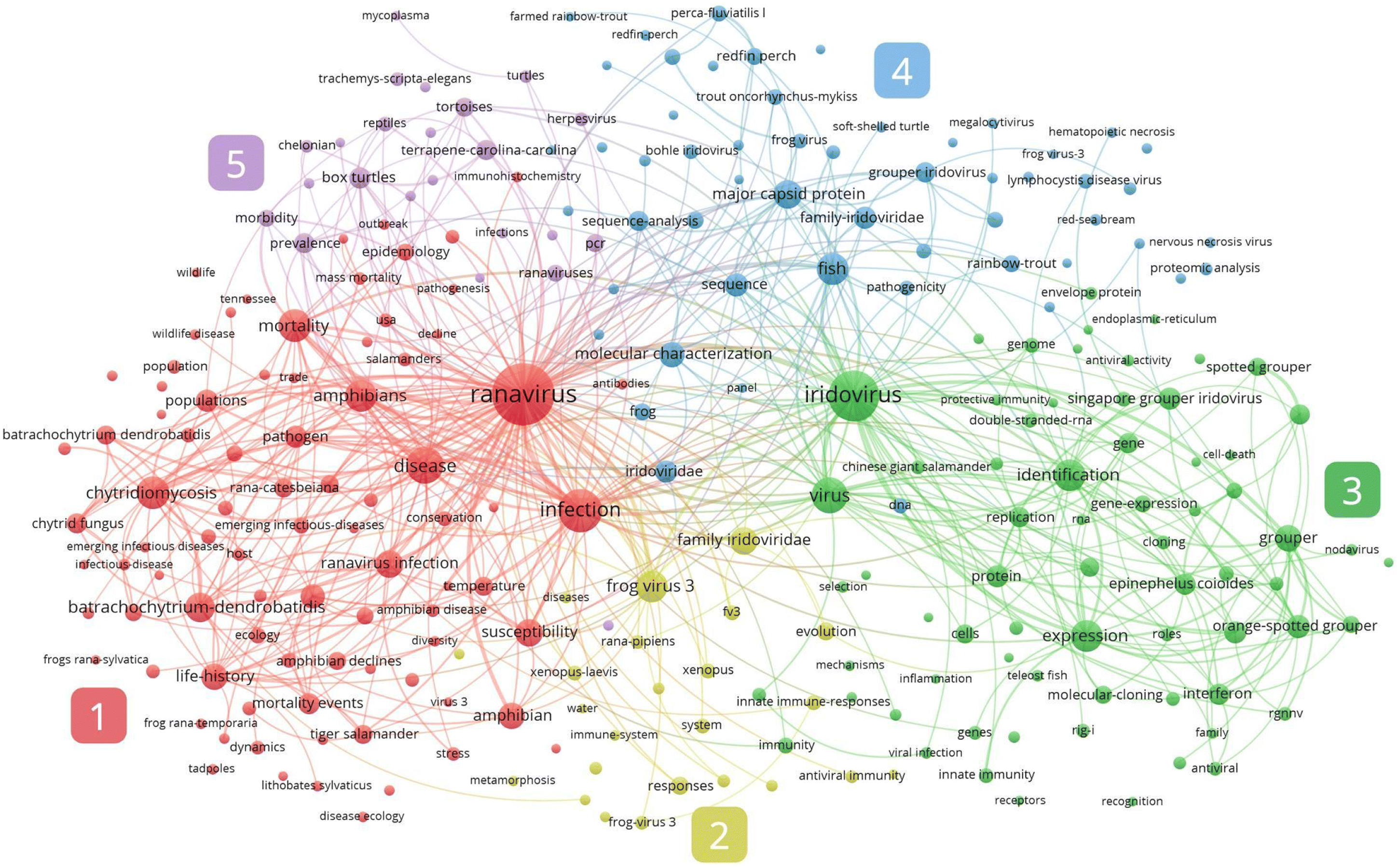
It is not surprising that “ranavirus” is the most common key word used by authors in the publications in the WOS ranavirus data set. However, this is not to say the research interest in this field is static (Fig. 5). Areas of research (author keywords) with high median year of publication include biosecurity, antiviral immunity, reptiles, etc. (Fig. 5). Interests in various infectious agents are changing as new species or strains of viruses get discovered. For instance, the median year of publication of publications from 2010 to 2019 that use Epizootic hematopoietic necrosis virus (discovered in the 1980s) as an author keyword was 2011, while the median year of publication for Andrias davidianus ranavirus (discovered in 2011) was mid 2018. From 2010 to 2019 over 50 articles have used keywords relating to Singapore grouper iridovirus (SGIV) indicating that SGIV is an important and stable research topic. Interestingly, Batrachochytrium dendrobatidis (Bd), another important pathogen of amphibians has appeared less frequently as an author keyword in the ranavirus literature in recent years (Fig. 5).
Fig. 5.
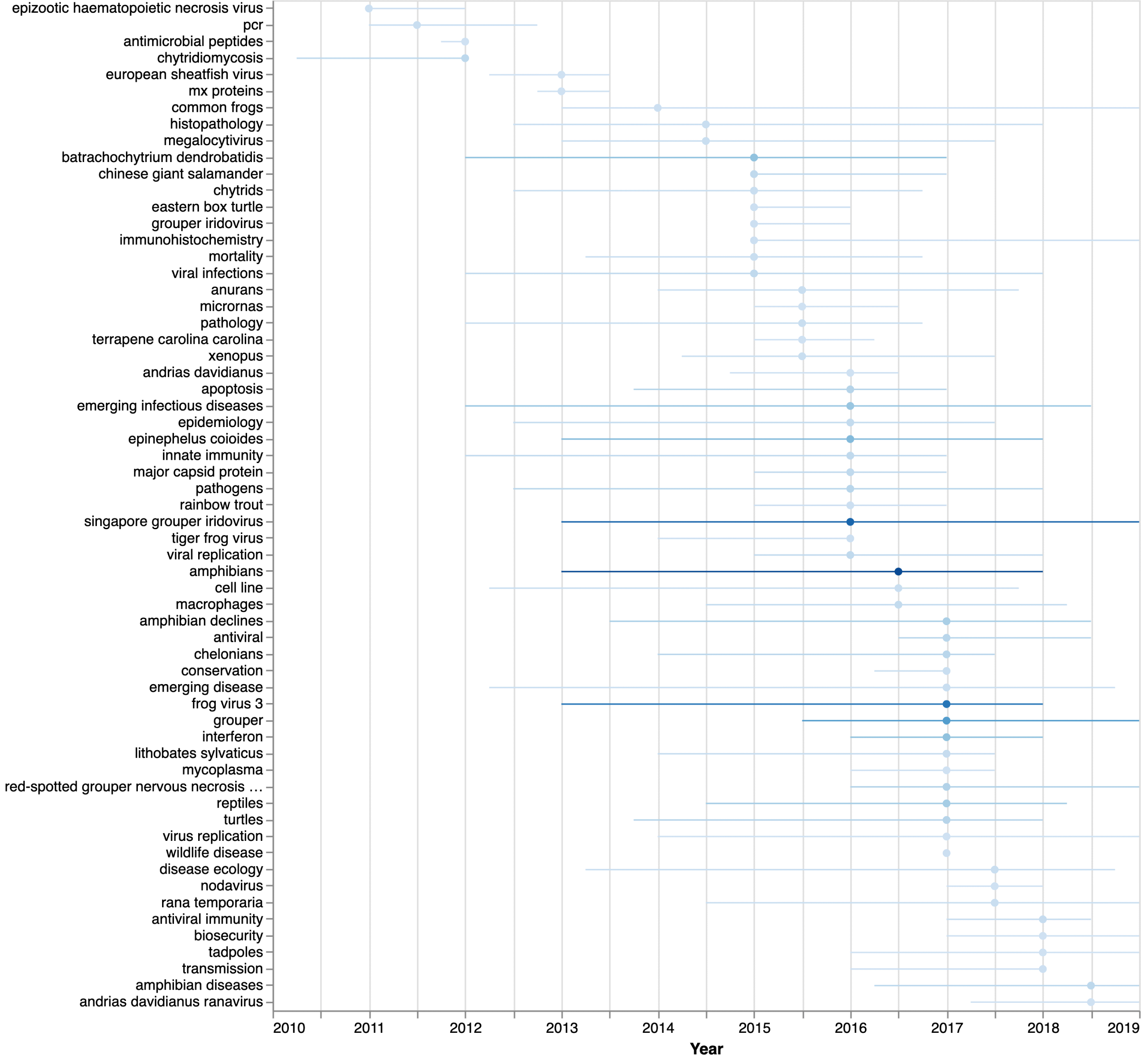
Collaborations and landscapes
Ranavirus research from 2010 to 2019 has been a global effort with authors in the WOS ranavirus data set hailing from 48 different countries and an increasing number of co-authors every year (average = 5.8; R = 0.90, p < 0.001; Fig. 6). Using co-author analysis, it was possible to visualise the collaborative landscape of the ranavirus field (Fig. 7). Central nodes like the US and England have more international collaborators, whereas peripheral nodes (e.g., Hungary, Thailand, Finland) have a less diverse set of co-authors (Fig. 7A). Interestingly, there are relatively few co-authorships shared between European (green) and Asian countries (red; Fig. 7A). There is a positive correlation between the distance between countries on the co-author map and the actual geographical distance between the countries (R = 0.338, p = 0.005). For the most part, bibliographic coupling (Fig. 7B) is similar to the co-authorship map, suggesting that researchers with similar interests are actively collaborating and refer to the same articles. However, there are a few cases where research interest and co-authorship are less aligned. For example, Germany clusters with the US, PRC, Australia, Canada, etc. (red group) in the bibliographic coupling map (Fig. 7B) but does not cluster with the same group in the co-authorship map (Fig. 7A). This may indicate that researchers from Germany are citing similar publications to those in the red group, and thus working on similar topics, but are not necessarily working with the researchers behind the publications they cite.
Fig. 6.
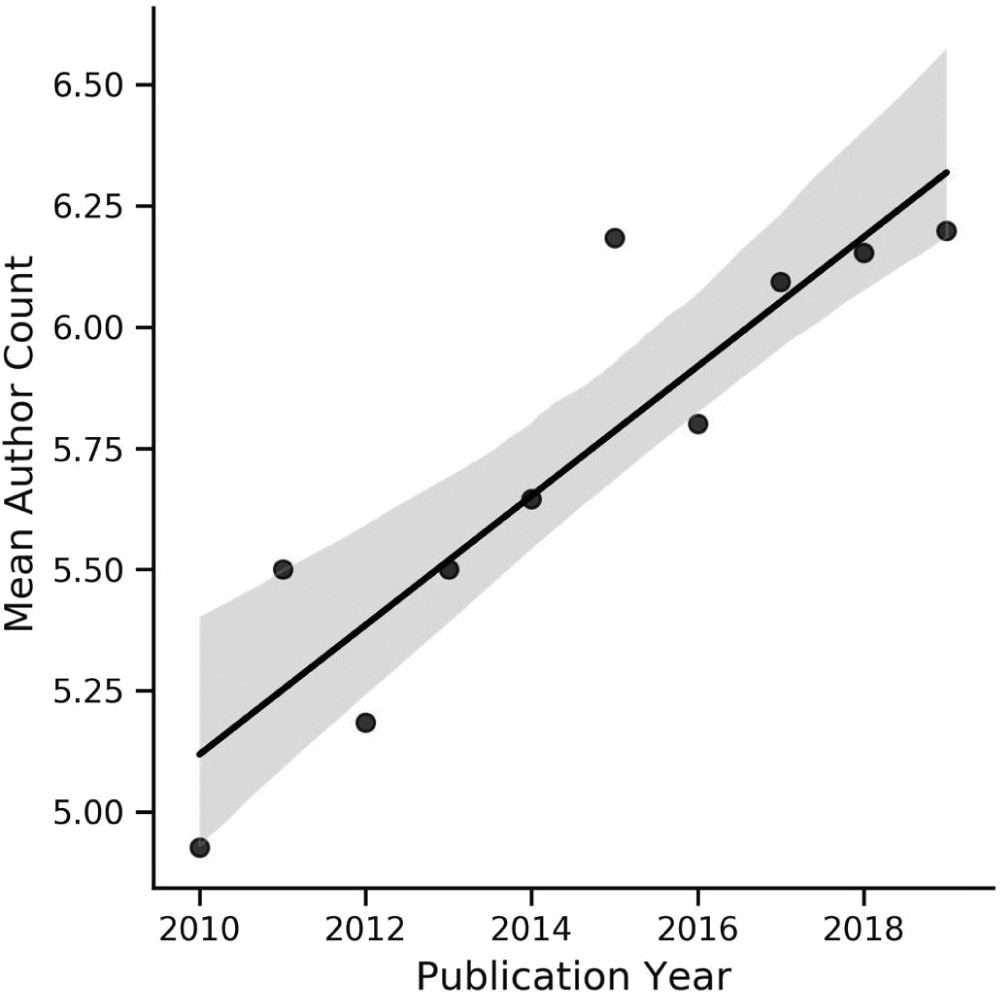
Fig. 7.
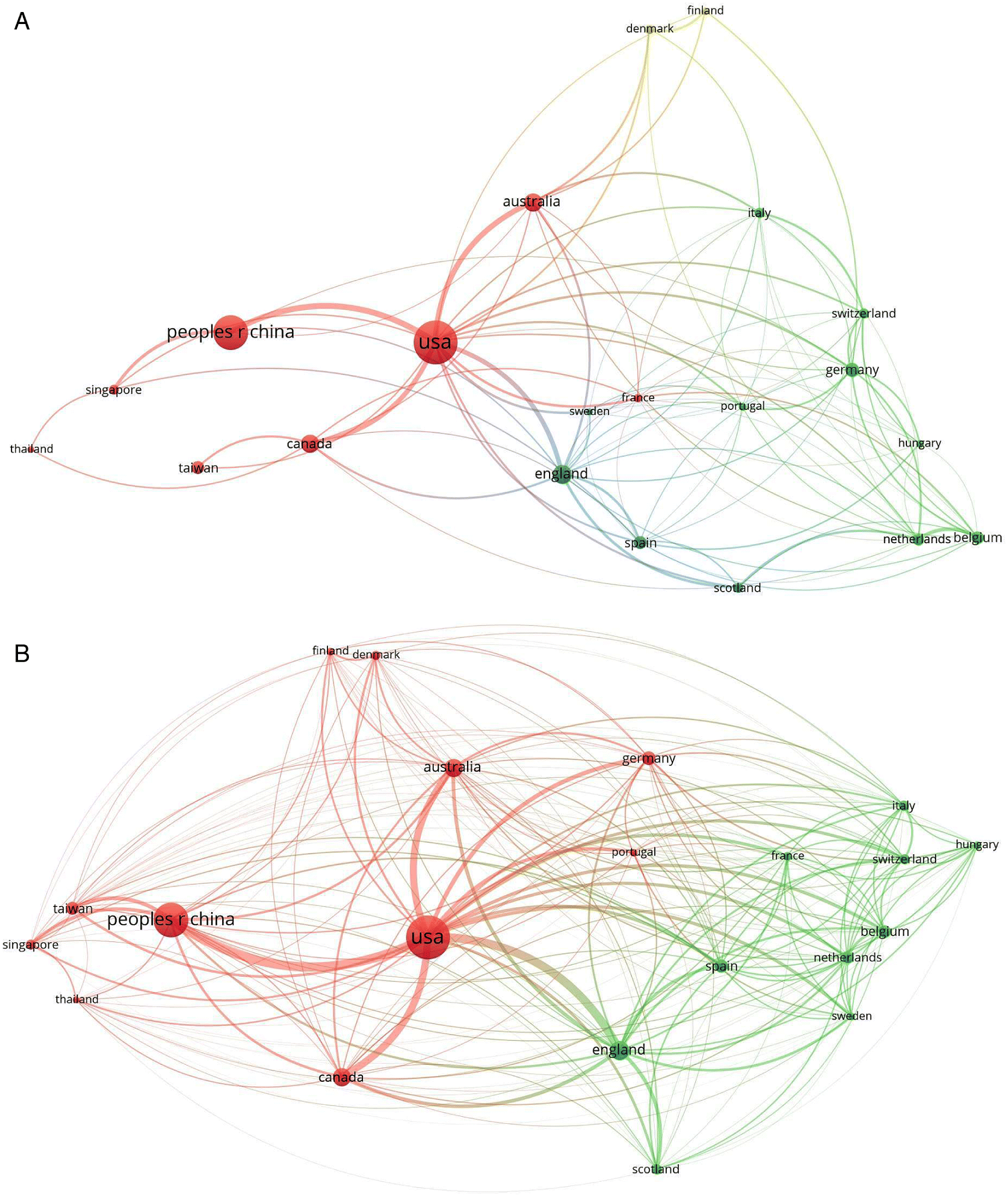
Discussion
Ranaviruses are important global pathogens of ectothermic vertebrates. The importance of and interest in ranavirus research is highlighted by the steady increase in ranavirus-related publications over the past 10 years. We ranked the publications in the WOS ranavirus data set based on citations from other publications in the data set to determine the core set of ranavirus publications. Inversely, the broader citations in the ranavirus auxiliary publications may be attributed to the fact that these publications tend to be focused on more general concepts such as amphibian decline (e.g., Hayes et al. 2010; Blaustein et al. 2012). More importantly, collaboration is an important component of continued productive ranavirus research output and our study reveals that the average number of co-authors on publications in the field has increased over the 2010–2019 period, possibly resulting in the increase in research output observed (Lee and Bozeman 2005).
Journals
Fish & Shellfish Immunology has 51 publications from 2010 to 2019, equating to 9.3% of the total publications in the WOS ranavirus data set. This journal is a specialised immunology journal and its place among the top ranavirus journals indicates the central role of immunology in this field. However, DAO received the most citations (572) during the same period but only represented 8.3% of the total citations for the data set. DAO was originally established in 1985 and focuses on all forms of life—animals, plants, and microorganisms—in marine, limnetic, and brackish habitats making it an excellent fit for ranavirus research that often involves aquatic species. PLoS ONE has the same H-index as DAO (14) for publications in the WOS ranavirus data set, and a total of 26 publications from 2010 to 2019. Although DAO has more publications (44), PLoS ONE has published higher impact papers (in terms of average citations). PLoS ONE is an interdisciplinary, open access journal that was founded in 2015 and despite its relatively recent creation, it is still one of the top journals for ranavirus research. The presence of these three top journals demonstrate the breadth of ranavirus research undertaken. Overall, ranavirus research is published in a range journals, with different specialisations and impacts. There is no clear “ranavirus journal” regardless of the metric used i.e., most citations, most publications, or H-index. The variety of journals publishing ranavirus papers may be a reflection of the variety of research that occurs within the field.
Keywords
The field of ranavirology is diverse, and there is active research in many areas. Core to ranavirology is the investigation of amphibian population declines and emerging infectious disease; however, other areas of research (molecular biology, genetics, herpetology, ichthyology, etc.) are also well represented. We also observed a cluster of keywords related to reptiles in the keyword map, indicating an increasing interest in viral infections associated with this clade (Wirth et al. 2018). In fact, three of the 10 publications in this special collection of FACETS are related to ranaviral infection in reptiles.
Between 2010 and 2019, topics of interest in the ranavirus field have been evolving. For instance, changes in the interest for particular viral isolates may be an indication of ecological importance of these viruses (i.e., those causing current epizootics) or simply a reflection of what is new. Interest in SGIV appears to be stable and this is likely the result of increased research output of researchers from Asia in the past 10 years, where SGIV is used as a model system for studying iridoviruses and remains a continuing problem for aquaculture in that part of the world (Qin et al. 2001; Ma et al. 2016). Interestingly, Bd has been used less frequently as a keyword in the WOS ranavirus data set in recent years. While often combined in early investigations of amphibian population declines, research on these pathogens is now established and ranaviruses and Bd are recognised as separate issues in their own rights.
Countries and collaborations
Bibliographic maps are useful for understanding a scientific landscape. The US, PRC, England, Canada, and Australia were the top countries in terms of total number publications between 2010 and 2019. The US has been the centre of ranavirology since the field originated there in 1965 with the discovery of Frog virus 3 (FV3) (Granoff et al. 1965) and is thus central in the bibliographic maps for collaboration and shared citations, indicating that researchers from the US are working on and collaborating on a diverse set of ranaviral related questions. The US has also hosted three of the five International Research Symposia (IRS) since 2011. Owing to their central location, researchers from this country should thus play a major role in fostering collaborations between some of the more disparate ranavirus researchers. By contrast, the PRC, despite being the second highest country in terms of research output, has not had the opportunity to host an International Symposium on Ranaviruses (ISR). The PRC is also less central in terms of the collaboration map when compared with the US and may thus benefit from an international symposium in terms of increased collaboration. We also noted a positive correlation between collaborating countries and their geographical distance. Reduced physical distance between collaborators would certainly lower the effort required for collaboration and it is also possible that researchers are working on geographically defined issues (where international collaboration is not required). However, there are cases where geographically close countries are not collaborating as much as they could (i.e., Australia and Asian countries). Since Ranaviruses are global pathogens, we recommend that some topics (e.g., phylogenetics, biosecurity, epidemiology, etc.) can or should ultimately be addressed on a global scale, requiring global collaboration.
Limitations
This scientometric analysis was based solely on the core collection of the WOS database. Although this feature-rich database is a standard for bibliometrics analysis, it is not exhaustive and some ranavirus-related references have been excluded (nonpeer-reviewed material for example). In addition, only the term “ranavirus” was used as a search term to generate the data set used in this study. We recognise that results may vary when using other databases (e.g., Scopus and Google Scholar) or alternative search terms. However, we chose to limit our search terms to reduce the number of false positives in the data set, and using a single database provided us with a consistent data set. We use citations as a proxy for impact and while this is a useful metric, we acknowledge that there are biases when using citation metrics and newer publications may not be favoured (Seglen 1997). Thus, all the conclusions presented here should be interpreted within the context of the limitations defined above.
Conclusions
In the past 10 years, ranaviruses have remained an active topic of research, with more publications every year. This bibliometric analysis of the ranavirus field has given valuable insight into the structure of the field and how collaborations and publications have evolved over the 2009–2019 period. The GRC was formed to facilitate communication and collaboration among scientists, veterinarians, and others interested in ranaviruses. Our study, and the collaborative nature of the articles published in this Collection reveal the success of this endeavor, but although the number of collaborators on ranavirus publications have increased, there are still geographical divides in the field. Thus, efforts should be made to foster collaborations across geopolitical and cultural boundaries, especially between countries with shared research interests. Ultimately, maintaining and promoting global research is central to understanding important global pathogens such as ranaviruses.
Acknowledgements
The authors would like to acknowledge the efforts of the organisers of 2019 International Symposium on Ranaviruses, which was held at James Cook University in Australia.
References
Blaustein AR, Gervasi SS, Johnson PTJ, Hoverman JT, Belden LK, Bradley PW, et al. 2012. Ecophysiology meets conservation: understanding the role of disease in amphibian population declines. Philosophical Transactions of the Royal Society B: Biological Sciences, 367: 1688–1707.
Chinchar VG, Yu KH, and Jancovich JK. 2011. The molecular biology of frog virus 3 and other Iridoviruses infecting cold-blooded vertebrates. Viruses, 3: 1959–1985.
Duffus ALJ, Waltzek TB, Stöhr AC, Allender MC, Gotesman M, Whittington RJ, et al. 2015. Distribution and host range of ranaviruses. In Ranaviruses. Edited by M Gray and V Chinchar. Springer, Cham, Switzerland. pp. 9–57.
Figg WD, Dunn L, Liewehr DJ, Steinberg SM, Thurman PW, Barrett JC, et al. 2006. Scientific collaboration results in higher citation rates of published articles. Pharmacotherapy, 26: 759–767.
Granoff A, Came PE, and Rafferty KA. 1965. The isolation and properties of viruses from Rana pipiens: their possible relationship to the renal adenocarcinoma of the leopard frog. Annals of the New York Academy of Sciences, 126: 237–255.
Gray MJ, and Chinchar VG. 2015. Introduction: history and future of ranaviruses. In Ranaviruses. Edited by M Gray and V Chinchar. Springer, Cham, Switzerland. pp. 1–7.
Hayes TB, Falso P, Gallipeau S, and Stice M. 2010. The cause of global amphibian declines: a developmental endocrinologist’s perspective. Journal of Experimental Biology, 213: 921–933.
Larivière V, Gingras Y, Sugimoto CR, and Tsou A. 2015. Team size matters: collaboration and scientific impact since 1900. Journal of the Association for Information Science and Technology, 66: 1323–1332.
Lee S, and Bozeman B. 2005. The impact of research collaboration on scientific productivity. Social Studies of Science, 35: 673–702.
Lesbarrères D, Balseiro A, Brunner J, Chinchar VG, Duffus A, Kerby J, et al. 2012. Ranavirus: past, present and future. Biology Letters, 8: 481–483.
Ma H, Peng C, Su Y, Feng J, and Guo Z. 2016. Isolation of a Ranavirus-type grouper iridovirus in mainland China and comparison of its pathogenicity with that of a Megalocytivirus-type grouper iridovirus. Aquaculture, 463: 145–151.
McKinney W. 2010. Data structures for statistical computing in Python. In Proceedings of the 9th Python in Science Conference (SCIPY 2010), 1697900, pp. 56–61.
Miller D, Gray M, and Storfer A. 2011. Ecopathology of ranaviruses infecting amphibians. Viruses, 3: 2351–2373.
Perianes-Rodriguez A, Waltman L, and van Eck NJ. 2016. Constructing bibliometric networks: a comparison between full and fractional counting. Journal of Informetrics, 10: 1178–1195.
Qin Q, Lam T, Sin Y, Shen H, Chang S, Ngoh G, et al. 2001. Electron microscopic observations of a marine fish iridovirus isolated from brown-spotted grouper, Epinephelus tauvina. Journal of Virological Methods, 98: 17–24.
Seabold S, and Perktold J. 2010. Statsmodels: econometric and statistical modeling with Python. In Proceedings of the 9th Python in Science Conference (SCIPY 2010). pp. 92–96.
Seglen PO. 1997. Citations and journal impact factors: questionable indicators of research quality. Allergy, 52: 1050–1056.
van Eck NJ, and Waltman L. 2010. Software survey: VOSviewer, a computer program for bibliometric mapping. Scientometrics, 84: 523–538.
Whittington RJ, Becker JA, and Dennis MM. 2010. Iridovirus infections in finfish—critical review with emphasis on ranaviruses. Journal of Fish Diseases, 33: 95–122.
Wirth W, Schwarzkopf L, Skerratt LF, and Ariel E. 2018. Ranaviruses and reptiles. PeerJ, 6: e6083.
Information & Authors
Information
Published In

FACETS
Volume 6 • Number 1 • January 2021
Pages: 44 - 57
Editor: Elena P. Ivanova
History
Received: 24 April 2020
Accepted: 29 September 2020
Version of record online: 21 January 2021
Notes
This paper is part of a Collection titled “Ranavirus research: 10 years of global collaboration.”
Copyright
© 2021 Wirth et al. This work is licensed under a Creative Commons Attribution 4.0 International License (CC BY 4.0), which permits unrestricted use, distribution, and reproduction in any medium, provided the original author(s) and source are credited.
Data Availability Statement
All relevant data are within the paper.
Key Words
Sections
Subjects
Authors
Author Contributions
All conceived and designed the study.
WW performed the experiments/collected the data.
WW analyzed and interpreted the data.
WW contributed resources.
All drafted or revised the manuscript.
Competing Interests
The authors have declared that no competing interests exist.
Metrics & Citations
Metrics
Other Metrics
Citations
Cite As
Wytamma Wirth, David Lesbarrères, and Ellen Ariel. 2021. Ten years of ranavirus research (2010–2019): an analysis of global research trends. FACETS.
6(): 44-57. https://doi.org/10.1139/facets-2020-0030
Export Citations
If you have the appropriate software installed, you can download article citation data to the citation manager of your choice. Simply select your manager software from the list below and click Download.
Cited by
1. Reptiles, Biodiversity of
2. Pathogenesis of Bohle iridovirus infection in Krefft’s freshwater turtle hatchlings (
Emydura macquarii krefftii
)
3. Prevalence of Ranavirus Infection in Three Anuran Species across South Korea
4. Scientometric Assessment of Global Research Output on ‘Pharmacopoeia’ (2000–2020)
